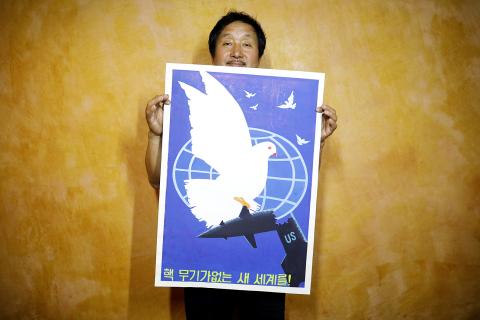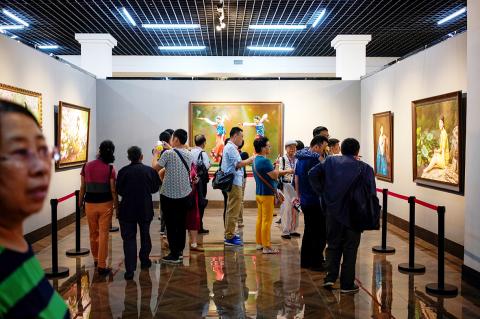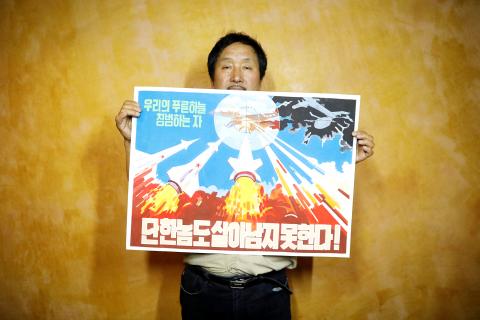Seated beneath tall windows and dressed simply in singlets and trousers, North Korean painters are hard at work. The artists staple canvases to frames or copy idyllic landscapes from laptop computers. One wears headphones as he brushes a group of running horses onto his canvas.
The nine men have come to the Chinese border town of Dandong from Mansudae Art Studio, North Korea’s largest producer of art. There are many outlets like this along the border; they house some of the thousands of North Korean artists who cater to burgeoning demand for their work.
“Chinese have begun collecting art, and North Korean art is much easier and cheaper for them to obtain,” says Park Young-jeong, a research fellow at the Korea Culture and Tourism Institute, a Seoul-based organization.

Photo: Reuters
In recent years as countries have responded to North Korea’s weapons tests with sanctions, Mansudae and other art studios have increasingly played a more controversial role — helping Pyongyang raise cash abroad. North Korea has long been punished for alleged underhand dealings in minerals, finance and arms; art was seen more as a channel for mutual understanding. That is changing.
Mansudae is run by the North Korean state. Its output ranges from statues of global leaders to propaganda posters, embroidery and more. It has built monuments and statues in at least 15 African countries, according to independent UN sanctions experts.
In a report in February, they said that a part of Mansudae called Mansudae Overseas Projects was a front for the North Korean state to cash in on military deals. As well as monumental statues, they found it built military installations such as a munitions factory and bases in Namibia.

Photo: Reuters
The North Korean UN mission did not respond to a request for comment and no one from Mansudae could be reached.
The UN Security Council banned Mansudae’s statue business in last year. On Aug. 5, after Pyongyang conducted more weapons tests, the Security Council blacklisted Mansudae Art Studio, subjecting it to a global asset freeze and travel ban. Diplomats say this will prevent Mansudae from conducting business.
“With this listing, anything Mansudae produces — including paintings, other artwork, monuments, buildings and other construction — cannot be bought and should be frozen per the asset freeze,” said a UN Security Council diplomat, speaking on condition of anonymity.

Photo: Reuters
In a further resolution on Sept. 11, the Security Council decided that all joint ventures with North Korean entities or individuals must be shut down within 120 days, or by mid-January.
Exactly what the measures mean for existing Mansudae art has yet to become clear. In Beijing’s art district, a gallery called the Mansudae Art Gallery says it is the studio’s official overseas gallery. Its head insists the sanctions do not apply to it and says they have had no impact on his business.
“Now more than ever we need avenues like art to create understanding between North Korea and the rest of the world,” said Ji Zhengtai.

Photo: Reuters
It is not possible to estimate the total value of Mansudae’s dealings, but the Security Council diplomat said the business had earned tens of millions of dollars globally.
‘WE DON’T DO POLITICS’
Mansudaeartsudio.com, a Web site in Italy which calls itself Mansudae’s “official Web site abroad,” says the studio is “probably the largest art production center in the world.”
Mansudae’s Pyongyang studio covers 120,000 sq m (nearly 30 acres), employs about 4,000 people including around 1,000 artists, and is divided into 13 creative groups, seven manufacturing plants and more than 50 supply departments, the Web site says.
The Web site is run by Pier Luigi Cecioni, who sells Mansudae works online and at fairs through what he calls an exclusive agreement with Mansudae Art Studio. He declined to say how much he sells, but in August after the sanctions on Mansudae Art Studio were announced, he told Reuters that the revenues go direct to the studio to pay for paints and equipment.
Cecioni said he sells works from his personal collection, most of them bought several years ago — before sanctions on Mansudae were announced. His Web site makes clear that any online purchase is made with his Italian company, not Mansudae. UN sanctions are not retroactive.
A panel of independent experts is charged with monitoring UN sanctions on North Korea. It reports violations and recommendations to the Security Council’s North Korea sanctions committee. Its reports are confidential, but the committee traditionally publishes annual reports.
Hugh Griffiths, who heads the panel, declined to comment, saying “the matter is subject to an ongoing investigation.”
Cecioni said, “the last thing I want is to have trouble with Italian or American authorities. I have strong contacts, especially with the Italian ones, and they help me to respect all the rules.” An Italian foreign ministry source said it is customary to keep contact with everyone who has ties to countries under sanctions, to ensure they respect Italy’s international commitments.
Last month, Cecioni said that he had no plans to shut down his operation. “I consider it very important to let people know that ... North Koreans do not make only bombs but also art and are common people,” he said. He postponed an exhibition of propaganda posters he had planned for September in Treviso, but said this was because Mansudae’s representatives told him they thought it unwise to showcase their anti-US tone in the current climate.
Word of the sanctions has been slower to reach China. A circular from its Commerce Ministry announcing the start date of the measures which included Mansudae Art Studio does not name Mansudae. Asked why not, the ministry did not respond.
The Dandong center works in partnership with Mansudae, said its manager, Gai Longji. Asked on the day the sanctions took effect if they were affecting business, he did not answer directly.
“We don’t do politics,” he said. “We do art.” Liaoning Sanyi, the firm behind the center, did not respond to a request for comment.
WHITE TIGER
Reuters spoke to at least 30 experts — collectors, art historians, academics and people who have sold North Korean art globally. Many said the market for paintings is niche and amounts to little in terms of revenue compared with the billion-plus dollars North Korea has raised every year selling coal and other minerals abroad.
Even so, they say North Korean diplomats in Europe have been enthusiastic to promote art exhibitions with the simple aim of bringing in hard currency.
In China, demand has really taken off. Dandong is a popular attraction for tourists who come to peep at North Koreans over the Yalu River border. Busloads of tourists show up every morning. Visitors sample North Korean noodles in cold soup, watch North Korean women sing and dance and buy North Korean paintings.
Besides Mansudae, just about every ministry and almost all the local authorities in North Korea have an art studio, said Koen De Ceuster, a lecturer in Korean studies at Leiden University who has been studying North Korean art for over a decade. “There’s studios all across the country,” he said.
Other prominent studio names include Paekho and the Central Arts Studio. Paekho, which means “white tiger” in Korean, is the biggest seller of popular paintings in Dandong, traders there said. Collectors who have dealt with Paekho say it is run by North Korea’s military — Reuters could not independently establish this. Paekho’s varied output includes propaganda posters calling for a nuclear-free world.
The Dandong center that Reuters visited has hosted around 500 North Korean artists since 2014, manager Gai said. They stay for between six months and three years.
Many Dandong galleries house North Korean painters. Staff there said they have sold North Korean paintings for as much as US$100,000 to buyers around the world. Art experts agree the pieces can very occasionally fetch six-figure sums.
Not all the proceeds go to Pyongyang. Mark-ups can reach four or five times the dealer’s purchase price, according to one Dandong dealer.
LONG GAME
While the Security Council’s Aug. 5 sanctions targeted only Mansudae, its resolution this month on joint ventures also included restrictions on North Korean labor: This combination could hurt everyone in the art business, Dandong traders say.
But there are ways around the measures, they add. For instance, paintings from Mansudae could be sold under the name of an art studio that hasn’t been sanctioned. Artists come to China under cultural exchange visas, not as workers. And two businessmen said paintings have long been accepted instead of cash in the barter deals that fuel the region’s economy.
At the other end of the border from Dandong in the city of Yanji, Chinese antiques dealer Zhao Xiangchen said people usually roll up a couple of paintings and carry them quietly across the border to him.
His antiques stall was thick with dust as he camped in a vacant slot next door, selling the paintings online.
Since the sanctions were announced, Zhao said, Chinese customs have become more vigilant.
“But I’m playing the long game,” he said. “I still think there’s huge latent demand for North Korean art in the Chinese market, that’s only set to grow.”

In the March 9 edition of the Taipei Times a piece by Ninon Godefroy ran with the headine “The quiet, gentle rhythm of Taiwan.” It started with the line “Taiwan is a small, humble place. There is no Eiffel Tower, no pyramids — no singular attraction that draws the world’s attention.” I laughed out loud at that. This was out of no disrespect for the author or the piece, which made some interesting analogies and good points about how both Din Tai Fung’s and Taiwan Semiconductor Manufacturing Co’s (TSMC, 台積電) meticulous attention to detail and quality are not quite up to

April 21 to April 27 Hsieh Er’s (謝娥) political fortunes were rising fast after she got out of jail and joined the Chinese Nationalist Party (KMT) in December 1945. Not only did she hold key positions in various committees, she was elected the only woman on the Taipei City Council and headed to Nanjing in 1946 as the sole Taiwanese female representative to the National Constituent Assembly. With the support of first lady Soong May-ling (宋美齡), she started the Taipei Women’s Association and Taiwan Provincial Women’s Association, where she

It is one of the more remarkable facts of Taiwan history that it was never occupied or claimed by any of the numerous kingdoms of southern China — Han or otherwise — that lay just across the water from it. None of their brilliant ministers ever discovered that Taiwan was a “core interest” of the state whose annexation was “inevitable.” As Paul Kua notes in an excellent monograph laying out how the Portuguese gave Taiwan the name “Formosa,” the first Europeans to express an interest in occupying Taiwan were the Spanish. Tonio Andrade in his seminal work, How Taiwan Became Chinese,

Mongolian influencer Anudari Daarya looks effortlessly glamorous and carefree in her social media posts — but the classically trained pianist’s road to acceptance as a transgender artist has been anything but easy. She is one of a growing number of Mongolian LGBTQ youth challenging stereotypes and fighting for acceptance through media representation in the socially conservative country. LGBTQ Mongolians often hide their identities from their employers and colleagues for fear of discrimination, with a survey by the non-profit LGBT Centre Mongolia showing that only 20 percent of people felt comfortable coming out at work. Daarya, 25, said she has faced discrimination since she